As winter winds down and everyone looks ahead to the exciting spring and summer show season, there are preparations that can be taken in your horse’s care to ensure you get off on the right hoof. Close communication with your veterinarian can help you stay on track and ensure everything is properly addressed. Vaccinations, deworming, therapies and treatments, as well as shipping care and paperwork are all important to think about. At Palm Beach Equine Clinic in Wellington, FL, Dr. Elizabeth Barrett works with her clients to stay organized for the upcoming show season.
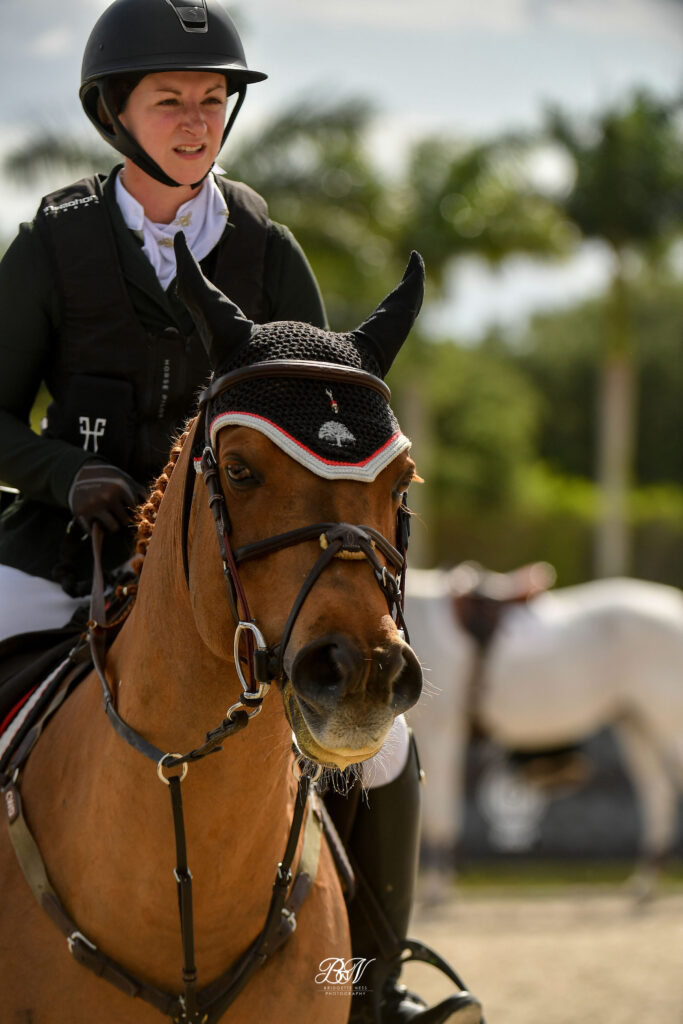
Photo by Bridget Ness Photography
Vaccinations
Horses are generally vaccinated twice per year in the fall and spring. If you and your horse are traveling to a new area for the spring and summer season, it is important to think about the requirements of that area or diseases more commonly found there. As an example, Dr. Barrett notes that the Potomac Fever vaccine is not always administered in Florida but can be important for horses traveling to the northeastern part of the country.
Vaccinations also need to be administered with enough time prior to shipping or competing, making scheduling considerations more crucial. Dr. Barrett maintains consistent communication with her clients to find the most optimal day to vaccinate such that it coincides with the horse’s existing schedule. While horse owners and barn managers help organize timing, Dr. Barrett stays prepared on her end by counting her patients and ordering enough vaccines for them.
“The responsibility goes both ways,” said Dr. Barrett. “Usually, the farm manager will let me know that they have some time off from showing, so it’s a good time for spring vaccines. I might also remind them that it’s getting to be time to do that so they can work it into their schedules.”
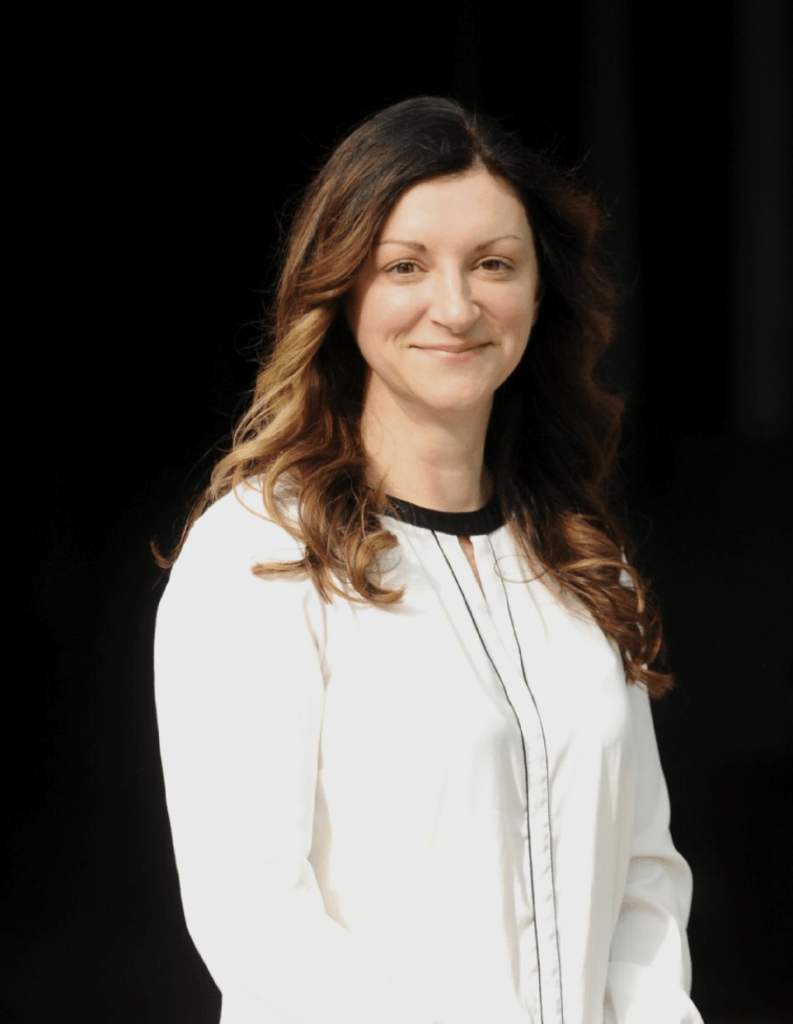
Photo courtesy of Dr. Elizabeth Barrett
Deworming
Springtime is also a good opportunity to deworm. When horses have traveled from one area to another, it is more crucial. While Dr. Barrett recommends worming twice annually, she explained that it is necessary to pay attention to each individual horse. Examining the horse and knowing the horse’s situation should guide the worming program. Horses that show clinical signs of worms, such as issues with weight and coat, should have a fecal egg count performed no matter what time of year.
Therapies and Treatments
Many horses are completing busy winter show schedules and heading into a break before ramping back up again. This downtime is a great window of opportunity to help address any issues that may have emerged. Dr. Barrett suggests having your horse treated at the beginning of a break to allow more time for the treatment to settle in. Some joint injections and therapies require longer recovery times, so that needs to be planned accordingly.
“After the winter show circuit, I go over all the horses completely to see if there are any issues,” detailed Dr. Barrett. “If there is any lameness or any maintenance we need to do, we try to time it so that the horse has at least a small break before they ship to their next show. Sometimes the horse just needs downtime, and during the spring is often the time they can get that rest. It’s also a good time for different training routines, such as a water treadmill or hill work to change up the program a little bit.”
Shipping
Spring and summer showing and shipping go hand in hand. Remembering all the paperwork that needs to be completed ahead of time is key to avoiding a last-minute scramble. Health certificates and Coggins papers are necessary documents for horses to travel both domestically and internationally. Dr. Barrett notes that it takes at least two days for a vet to complete this paperwork for national travel, so it is essential to keep that in mind when arranging an interstate trip. International travel health certificates take longer to prepare and have more requirements, necessitating additional forethought.
Once the logistics are handled, the horse must be physically prepared to ship. The longer the trip, the more stress it can put on the horse. Even trips as few as three hours can increase health concerns. Stomach ulcers are always a risk, so Dr. Barrett suggests administering preventative omeprazole paste to help keep your horse comfortable. Again, Dr. Barrett stresses that each horse needs to be considered individually, so a horse more prone to ulceration might also benefit from sucralfate when shipping.
“I would scope the stomach of any horse we are worried about that is clinically showing signs that they could have ulcers,” shared Dr. Barrett. “When they ship, it helps to try to feed them a little bit at a time with a steady supply of hay throughout the trip so that their stomach is full.”
Shipping fever and colic are other common issues. Taking your horse’s temperature and monitoring their behavior can help detect the problem sooner. Dr. Barrett also offers a couple of tricks to keep your horse hydrated and feeling comfortable in travel. Feeding a wet mash with mineral oil before the journey helps prevent impaction. Getting your horse accustomed to an electrolyte-flavored water beforehand allows you to produce the same familiar flavor on the road to encourage even the most stubborn drinker.
Additional precautions can be made to prevent other injuries. Considering the horse and weather will guide the best plan. For example, in warmer weather a horse that travels well might do better without wraps, but a horse that is more self-destructive could still need extra protection. Certain halters can cause rubs in warmer weather too. Dr. Barrett cautions that injury can also be caused by a travel buddy.
“It is really important to pay attention to what horses are next to each other,” emphasized Dr. Barrett. “I’ve seen plenty of injuries where one horse is picking on another and causing trouble. I’ve seen more injuries from that than self-inflicted horse wounds, but both can happen. You have to be careful.”
It helps to have cameras on the horses during longer trips to ensure there are no issues. Since the driver usually stops for gas every four hours or so, that is a good time to check on the horses and offer water. For trips of more than 10 hours, it can help to stop and unload the horses to give them a break. Many commercial shippers will drive directly, so in those cases, the health preparations you make are even more significant.
In all of your organization for spring, the most important thing is to stay in contact with your veterinarian. They will be able to inform your decisions, help with timing issues, and make the best possible plan for you and your horse.
Which veterinarian do you work with, and how long have you been at Palm Beach Equine Clinic?
I work with Dr. Bryan Dubynsky who specializes in sport horse medicine. I started working at Palm Beach Equine Clinic at the beginning of 2022. I began as a veterinary technician in the Hospital Barn and then transitioned to working with Dr. Dubynsky.
What does a typical day look like for you at Palm Beach Equine Clinic?
A typical day starts with restocking the vet truck. I always make sure we have all the drugs and supplies we will need for the day. Once the truck is stocked, we spend the day traveling to different barns in the area treating and evaluating horses.

Photo courtesy Laura Romero
What made you decide to become a veterinary technician?
I grew up in Okeechobee, FL, and I enrolled in my high school’s veterinarian program. I was also part of the agricultural program at my school. I found both of those courses very interesting, and they inspired me to become a veterinary technician.
What is your background with horses?
I grew up riding western as a kid and always loved being around horses.
What do you enjoy doing in your free time?
I love to travel and spend time with my friends.
When Natasha Masri purchased Gypsy, a then four-month-old miniature donkey, on October 21, 2022, she could not wait to take her new pet home. Less than two weeks later Gypsy arrived at Masri’s farm along with four other miniature donkeys and horses.
While the other new animals were thriving at Masri’s farm, Gypsy’s health slowly started to decline. By January of 2023, Masri could tell that Gypsy was not herself. The young miniature donkey was lethargic, laying down a lot, and losing weight. Masri called her regular veterinarian to examine Gypsy. After a few days it was evident that Gypsy’s condition was not improving so Masri and her veterinarian decided to call Palm Beach Equine Clinic in Wellington, FL, for an internal medicine specialist.

Photo courtesy of Dr. Fernando Marqués
“Within two hours Dr. Fernando Marqués was at our farm ready to help,” recalled Masri. “When I met Dr. Marqués my anxiety vanished because I could tell he knew what he was doing. He was very good about talking to me as he was working with Gypsy, which was invaluable to me as someone without a medical background.”

Photo courtesy of Dr. Fernando Marqués
Dr. Fernando Marqués, a board-certified internal medicine specialist, began his evaluation of Gypsy by asking Masri for the miniature donkey’s medical history. Masri explained Gypsy was lethargic, losing weight, had a fever, and had bloodwork abnormalities. Dr. Marqués then continued with a physical exam to learn more about Gypsy’s overall health.
“When I did a physical exam of Gypsy, I found a cardiac murmur,” explained Dr. Marqués. “The cardiac murmur was consistent with the laboratory finding, which was regenerative anemia. The thickness of the blood changes when an animal has anemia, and that can create a cardiac murmur. After discovering that, we decided to investigate the diagnosis of regenerative anemia further. We always want to try to fix the underlying problems and really get to the root of the issue.”
The next step included Dr. Marqués taking ultrasounds of Gypsy’s thorax and abdomen.
“On the right side of the thorax there were some minor ultrasonographic changes but otherwise everything else looked normal,” said Dr. Marqués. “Then we went ahead and did imaging of the thorax and abdomen with x-rays. In this case, we wanted to determine if it was a nutritional problem, an infection, a parasite, or something else. On radiography, there was nothing relevant that I could find.”
After examining Gypsy, Dr. Marqués, Masri, and her regular veterinarian decided that the miniature donkey should be sent to Palm Beach Equine Clinic for further evaluation. Gypsy arrived at the clinic, and Dr. Marqués immediately started her on intravenous (IV) fluids, vitamin B12, and a dewormer. He also ran additional blood tests beyond the ones the regular veterinarian completed at Masri’s farm and performed a fecal test.
“While Gypsy was at Palm Beach Equine Clinic, we gave her IV fluids, monitored her, made sure she was eating enough nutrients, and performed bloodwork tests,” explained Dr. Marqués. “We found Gypsy’s regenerative anemia was multifactorial, infectious, parasitic, and nutrition related. After a few days of a dewormer and a different feeding program, she started eating really well and gaining weight again. All the blood parameters were normalizing as well. During this time, I was in contact with Masri and her regular veterinarian so we could work as a team. It was important we were all on the same page and communicating on a daily basis.”
After five days of receiving a different feeding program and a parasite treatment at Palm Beach Equine Clinic, the team decided that Gypsy could return home under the care of Masri’s regular veterinarian. Dr. Marqués outlined a new feeding plan for Gypsy to make sure she was getting all of the nutrients she needed. Masri also switched Gypsy over to timothy hay, which is easily digestible and has high fiber and energy content. Additionally, Dr. Marqués and Masri decided it might be best to feed Gypsy separately from the other animals to ensure she was eating her entire portions of grain and hay. Once Gypsy was back home, Dr. Marqués continued to check in with Masri and her regular veterinarian.
“I was extremely impressed with the way Dr. Marqués was able to collaborate with our general veterinarian,” described Masri. “He kept her in the loop so when Gypsy came home there was a plan in place and everyone was communicating.”

Photo courtesy of Dr. Fernando Marqués
Since coming home to the farm, Gypsy has returned to being energetic and running around with the other miniature donkeys and horses as she did when Masri first met her.
“As a new miniature donkey and horse owner, having a go-to for these animals at the beginning of their lives leaves me feeling so grateful and confident that I can handle anything with them,” said Masri. “Anytime I have an emergency, Palm Beach Equine Clinic will be the first place I call.”
“As a new miniature donkey and horse owner, having a go-to for these animals at the beginning of their lives leaves me feeling so grateful and confident that I can handle anything with them,” said Masri. “Anytime I have an emergency, Palm Beach Equine Clinic will be the first place I call.”
Since coming home to the farm, Gypsy has returned to being energetic and running around with the other miniature donkeys and horses as she did when Masri first met her. “As a new miniature donkey and horse owner, having a go-to for these animals at the beginning of their lives leaves me feeling so grateful and confident that I can handle anything with them,” said Masri. “Anytime I have an emergency, Palm Beach Equine Clinic will be the first place I call.”
Dr. Natalia Novoa has been part of the Palm Beach Equine Clinic team since 2011. Dr. Novoa focuses primarily on sport horse medicine, lameness, pre-purchase exams, chiropractic adjustments, acupuncture and preventative medicine.
When and why did you decide that you wanted to become a veterinarian?
I decided to become a veterinarian when I was in high school. I enjoyed working with animals at my family’s farm. I spent time with the farm’s vet, and I learned how to do artificial insemination before I even finished high school. I liked the problem-solving aspect of it. I found it fascinating to have the ability to identify and understand what the problem was and then help relieve the suffering of animals after injuries or illnesses. It was an indescribable sensation. Nothing beats helping an animal when they are sick or in pain. There is nothing more rewarding than knowing you are making a difference in a horse’s life. It is a very satisfying feeling.

Photo courtesy of Dr. Natalia Novoa
What aspects of equine medicine interest you most, and what types of cases do you find most rewarding?
I am most interested in sports medicine and lameness (conventional medicine) as well as alternative medicine (chiropractic adjustments and acupuncture). The most rewarding cases for me are the challenging ones where I have to “solve the puzzle.” I like when I have to rely on my detailed observation including a thorough exam and accurate history, then put together all the data and information I gathered from the diagnostic tools, choose the appropriate treatment, and then reach a successful outcome.
What do you enjoy most about working with performance horses?
I enjoy treating them as top athletes through the combined use of our practical skills, the new technology, and evolving therapies. At Palm Beach Equine Clinic, we are very fortunate to work on a variety of horses of all disciplines, including horses that are the best athletes in the world in dressage, show jumping, polo, etc. We use the most advanced equipment to provide the best service. Also, at Palm Beach Equine Clinic we have an amazing team of veterinarians with different specialties, knowledge, and skills to help these performance horses execute and perform at their best.

Photo courtesy of PBEC
What has been one of your favorite moments while working for Palm Beach Equine Clinic?
One of my favorite moments was when my daughter Lola told me she wanted to be a veterinarian after watching the process of resolving a challenging lameness case in a grand prix level show jumping mare. Lola was able to observe the positive outcome and cheered for the mare when she won a big jumper class.
What is something interesting that people may not know about you?
I am a fearless squash player, and I also enjoy playing tennis and ping pong. I love traveling with my family and showing my daughter Lola the world.
What is something interesting that people may not know about you?
I am a fearless squash player, and I also enjoy playing tennis and ping pong. I love traveling with my family and showing my daughter Lola the world.
The importance of good quality hoof care in competition horses cannot be denied. Farriery can be a major asset during the show season and beyond. The farrier can be proactive in keeping the horse’s feet healthy and thus preventing lameness. Learn more as Dr. Stephen O’Grady of Palm Beach Equine Clinic in Wellington, FL, explains the philosophy behind correct basic farriery in sport horses.
The Hoof
The equine hoof is unique as it is comprised of a group of biological structures (anatomy) that follow the laws of biomechanics. Therefore, if the veterinarian and farrier know the anatomy of the equine foot combined with an understanding of the biomechanics and good basic farriery principles, proper physiological farriery can be consistently applied (see Figure 1A and 1B). There are three important aspects of farriery used to keep the horse sound, beginning with the appropriate foot trim, along with the correct size and placement of the horseshoe.
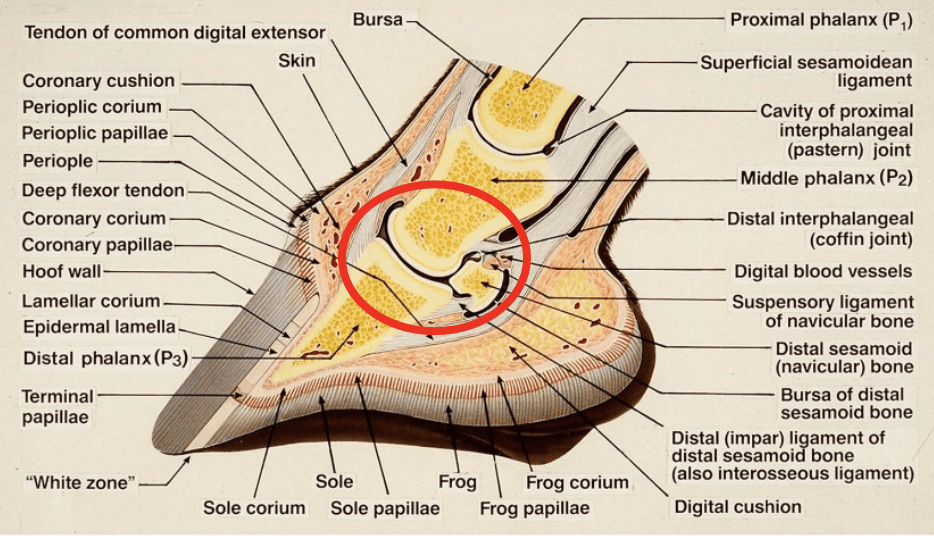

The farrier session begins with an evaluation of the conformation of each foot. This means viewing the foot from the front, the side, and behind to observe the height of the heel bulbs (see Figure 2). It is important for the clinician to observe the horse in motion to see whether the horse’s foot lands flat or slightly heel first, which is desired. If the horse lands markedly heel first with a toe flip, it is a sign the heels have migrated dorsally (toward the front), decreasing the ground surface in the palmar section of the foot, or the size of the shoes is too small. The foot that lands toe first is an indication that the musculotendinous unit of the deep digital flexor tendon is shortened or the horse is experiencing palmar foot pain. Lastly, the foot should be observed for an asymmetrical landing pattern that is dictated by limb conformation because, if severe, a heel bulb can be displaced proximally resulting in the foot conformation termed “sheared heels.”

The Trim
The use of guidelines or landmarks when approaching the trim provides consistent, repeatable results that can be used on each foot regardless of the conformation. The three guidelines used are: 1. Trimming the foot to achieve a straight or parallel hoof-pastern axis, 2. using the widest part of the foot, which correlates closely with the center of rotation, and 3. trimming the palmar foot (heels) to the base of the frog or to where the heels of the hoof capsule and the frog are on the same plane (see Figure 3A and 3B). A closer look at these three guidelines, which are all interrelated, will help to show their importance.

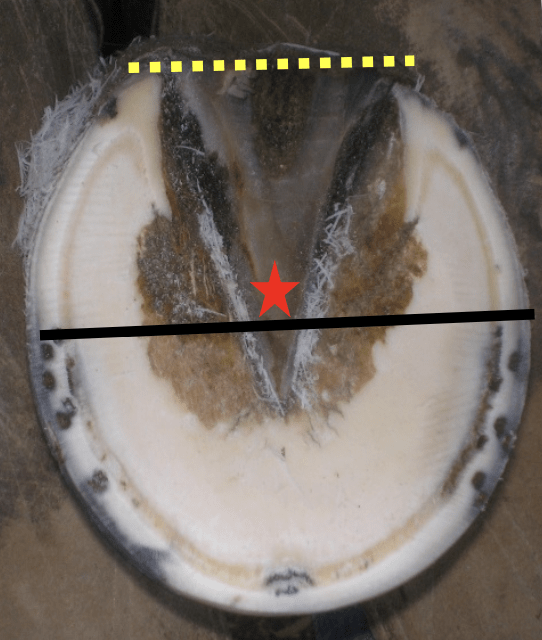
1. If the dorsal (front) surface of the pastern bone and the dorsal surface of the hoof are parallel or form a straight line, then the bones of the digit (in the hoof) are in a straight line, and the force from the weight of the horse will go through the center of the joint. Furthermore, and equally important, if the hoof-pastern axis is straight, the weight will be distributed evenly on the bottom or the solar surface of the foot.
2. The second guideline is the center of rotation (COR). The COR is located a few millimeters palmar (behind) the widest part of each foot. This guideline allows the farrier to apply the appropriate biomechanics to each foot. The foot is trimmed in approximate proportions on either side of the widest part of the foot, which addresses the moments on either side of the COR and provides biomechanical efficiency.
3. Lastly, the palmar section of the foot is trimmed to the base of the frog or trimmed such that the heels of the hoof capsule and the frog are on the same plane. Adherence to this guideline keeps the soft tissue structures (frog, digital cushion, ungula cartilages) within the hoof capsule, which is necessary to absorb concussion and dissipate the energy of impact (see Figure 4). It is important to remember that heels do not grow tall; they grow forward. If the heels migrate forward, the soft tissue structures will be forced in a palmar direction out of the hoof capsule. Furthermore, as the heels migrate forward, the weight is placed on the bone via the lamellae thus bypassing the soft tissue structures of the foot. Allowing the heels to migrate forward also decreases the ground surface of the foot. Two examples of this guideline are shown in Figures 5A, 5B and 6A, 6B where the palmar foot was managed appropriately, and a size larger shoe was applied.

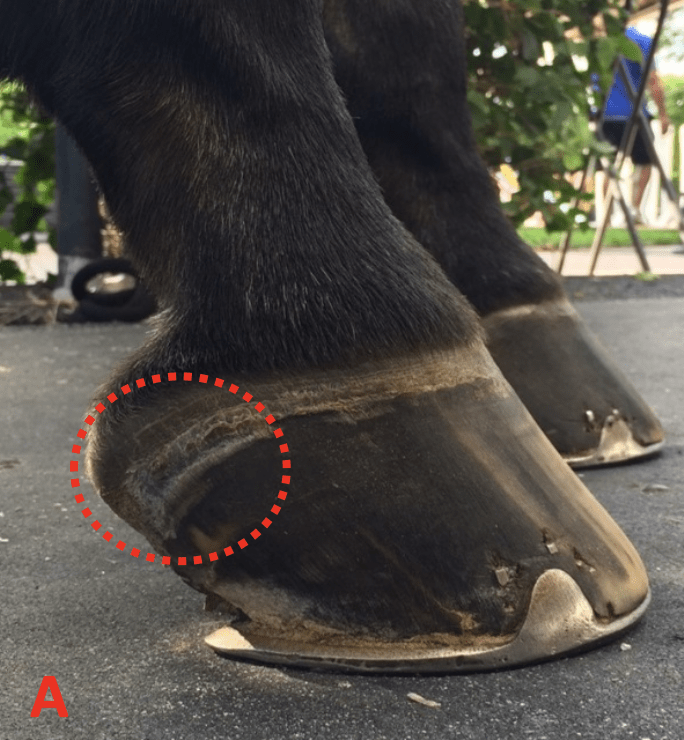


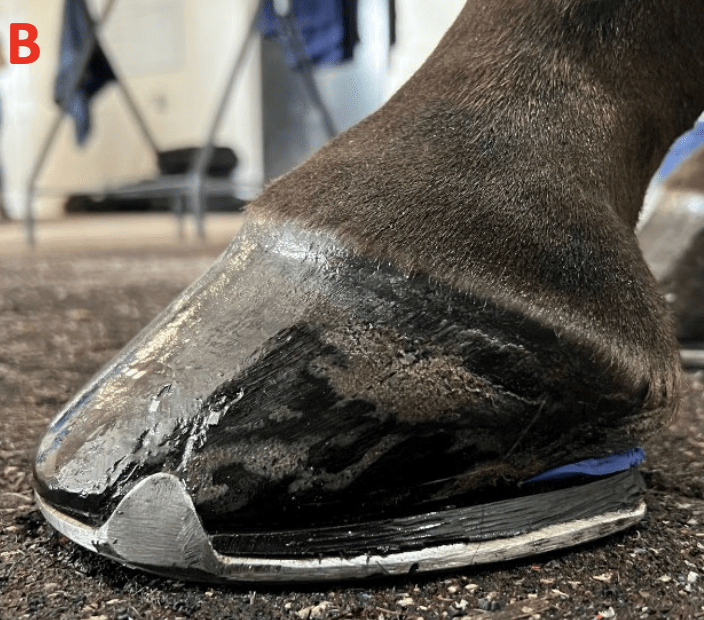
The three guidelines described here can be applied to any foot and can serve as a basis for maintaining a healthy foot and a basic starting point for applying farriery to a horse with poor foot conformation or one with a distorted hoof capsule. Figures 7A and 7B illustrate a hoof where all three of these guidelines have been applied.

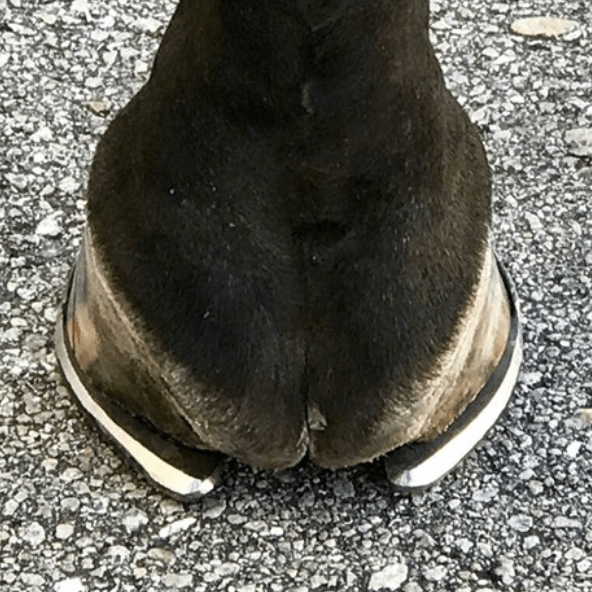
Thoughts From Dr. Stephen O’Grady
Most competition horses now show year-round instead of on a seasonal basis. My observation is based on years of experience regarding the farriery performed on these horses. Many of these horses are given a rest from competition prior to leaving for Wellington for the winter show season. Many horses arrive with very reasonable foot conformation. However, upon arrival, horses are often shod with various specialty shoes, wedges, pads, pour-ins, etc., as a means of protection and perhaps to enhance their performance.
As the season progresses and the workload becomes more intense, the sole thickness starts to decrease, and the feet become softer from multiple baths. Now the farriery that was applied for protection at the onset may be causing pressure on the thinner, softer structures of the foot, thus becoming somewhat detrimental. The horses continue to be trimmed and shod on a monthly basis, and the farrier may not be aware of the change in the integrity of the hoof structures, especially the sole, and perhaps some horses may be over-trimmed. As the season progresses into March, the structures of the foot deteriorate further as a result of the workload. Many horses begin to become foot sore. At this point, the farrier options become limited because all the protective methodology was already used at the beginning of the season.
One recommendation would be to refrain from trimming the sole (trade the hoof knife for a wire brush), create ground surface in the palmar foot with a rasp, and decrease toe length vertically from the dorsal section of the foot to preserve mass. Always remember that adequate breakover in the shoe is important, as it decreases the stress in the deep digital flexor tendon and decreases the moment about the distal interphalangeal joint, both of which preserve sole thickness.
I remember the words of Joe Pierce when I was an apprentice learning the farrier trade many years ago, “No one will know if you leave the last few rubs of the rasp on the foot, but everyone will know if you take a few too many rubs!”
Palm Beach Equine Clinic offers a farriery consultation service to both veterinarians and farriers. This unique service provides a second opinion or simply “another set of eyes” available to both professions when treating difficult farriery cases. Please call 561-793-1599 or visit equineclinic.com for more information.
Do you ever wonder what all those letters at the end of a veterinarian’s name actually mean? It is kind of like a secret language where they signify a variety of different veterinary qualifications. Palm Beach Equine Clinic explains how to crack the code of letters.
DVM
Doctorate of Veterinary Medicine: This qualification is given to graduates of veterinary colleges. Although this was once only for graduates of American veterinary colleges, the abbreviation is now given to graduates from several other universities around the world. The vast majority of the veterinarians at Palm Beach Equine Clinic are DVMs that earned their degrees at U.S. institutions.
DACVS
Diplomate of the American College of Veterinary Surgeons: Holders of this qualification are board-certified specialists in Surgery. Board-certified means that the veterinarian has a mastery of advanced knowledge and skills after completing required testing. At Palm Beach Equine Clinic, Dr. Robert Bruise, Dr. Jorge Gomez, Dr. Weston Davis, Dr. Liz Barrett, and Dr. Karen Beste are all specialist surgeons.

Photo by Jump Media
DACVIM
Diplomate of the American College of Veterinary Internal Medicine: This qualification means that the veterinarian is board-certified in Internal Medicine. Dr. Peter Heidmann and Dr. Fernando Marqués of Palm Beach Equine Clinic are both board-certified specialists in Internal Medicine.
DACVR
Diplomate of the American College of Veterinary Radiology: This qualification indicates the holder is a board-certified specialist in Radiology. Palm Beach Equine Clinic’s Dr. Sarah Puchalski is a DACVR.
DACVSMR
Diplomate of the American College of Veterinary Sports Medicine and Rehabilitation: A relatively new specialty, this qualification indicates the veterinarian is a board-certified specialist in Sports Medicine and Rehabilitation. Both Dr. Christopher Elliott and Dr. Fernando Marqués of Palm Beach Equine Clinic have this qualification.
BVETMED
Bachelor of Veterinary Medicine: This distinction is given to veterinary graduates of the Royal Veterinary College (RVC) in London, which is the first and oldest English-speaking veterinary college in the world. Dr. Richard Wheeler and Dr. Charlie McColough of Palm Beach Equine Clinic are both graduates of the famous RVC.
BVM&S
Bachelor of Veterinary Medicine & Surgery: These letters indicate a graduate of The Royal (Dick) School of Veterinary Studies in Edinburgh, Scotland, which is Scotland’s oldest veterinary school. Palm Beach Equine Clinic’s Dr. Sarah Allendorf is a Dick Veterinary graduate.
BVMS
Bachelor of Veterinary Medicine & Surgery: This particular abbreviation is given to graduates of several British veterinary schools. At Palm Beach Equine Clinic, Dr. Janet Greenfield Davis and Dr. Tyler Davis both have this qualification as graduates of the Glasgow University School of Veterinary Medicine.

Photo by Jump Media

Photo by Jump Media
BVSc
Bachelor of Veterinary Science: These letters were typically associated with veterinary graduates from Commonwealth countries such as Australia and New Zealand. The qualification is now granted by numerous vet schools around the world. Within Palm Beach Equine Clinic, Dr. Christopher Elliott has this qualification from the University of Queensland School of Veterinary Science in Australia.
MVB
Bachelor of Veterinary Medicine: This renowned abbreviation indicates graduates of the University College Dublin School of Veterinary Medicine, which is Ireland’s only veterinary school. Dr. Laura Hutton of Palm Beach Equine Clinic is a University College Dublin School graduate.
MVZ
Medico Veterinario Zootecnista: This qualification is given by several Spanish-speaking veterinary schools. Palm Beach Equine Clinic’s Dr. Jorge Gomez has this qualification as a graduate of the University of Caldas in Colombia.
MRCVS
Member of the Royal College of Veterinary Surgeons: These celebrated letters indicate the holder as satisfying the stringent regulatory requirements to practice as a Veterinary Surgeon in the United Kingdom. At Palm Beach Equine Clinic, Dr. Richard Wheeler, Dr. Scott Swerdlin, Dr. Stephen O’Grady, Dr. Janet Greenfield Davis, Dr. Tyler Davis, Dr. Charlie McColough, Dr. Sarah Allendorf, and Dr. Christopher Elliott are all MRCVS.
MANZCVS
Member of the Australian and New Zealand College of Veterinary Scientists: These letters indicate the veterinarian has studied at the Australian and New Zealand College of Veterinary Scientists and is an advanced practitioner in a particular area of veterinary science. Dr. Christopher Elliott of Palm Beach Equine Clinic is a MANZCVS in Equine Sports Medicine and Rehabilitation.

Photo courtesy of Dr. Christopher Elliott
CERPM
Certified in Equine Rehabilitation & Performance Medicine: This is a post-veterinary school qualification focusing on the early diagnosis of performance deficits, how to correct them, and rehabilitation after injury. Palm Beach Equine Clinic’s Dr. Janet Greenfield Davis holds this qualification.
CVA
Certified in Veterinary Acupuncture: Veterinarians with this post-veterinary school qualification have studied the fundamentals of equine acupuncture including points and techniques. This is a postgraduate qualification also held by Dr. Janet Greenfield Davis.
CVMMP
Certified Veterinary Medical Manipulation Practitioner: This is a post-veterinary school qualification where veterinarians are educated in how to perform medical manipulation to treat musculoskeletal problems. Dr. Ryan Lukens of Palm Beach Equine Clinic has this qualification.
Dr. Karen Beste joined the Palm Beach Equine Clinic team in January 2023. Dr. Beste is a board-certified large animal surgeon. Keep reading to learn more about Dr. Beste and her background as a veterinarian.
Where did you grow up and what is your background with horses?
I grew up in a small town in north Texas called Double Oak. My father loved horses. His parents had a small property with several horses and a Shetland pony that I learned to ride on. We were involved with the Lewisville Saddle Club and went to “playdays” together throughout my childhood where I learned how to barrel race and compete in speed events. During this time I started to train my own horse named Buck. I joined the Marcus Rodeo Team and competed in high school rodeo for four years with Buck who took me to the finals for pole bending my senior year. In college I switched gears and joined the Texas A&M University polo club my freshman year. I quickly fell in love with the game, and through a lot of hard work I made the polo team my sophomore year. During my senior year I went on to be the team captain.
When and why did you decide you wanted to become a veterinarian?
I decided I wanted to be a veterinarian at a very young age. When one of our horses became injured and ultimately had to be euthanized despite surgical intervention efforts I knew I wanted to be able to help horses as a career. In third grade I wrote a book describing how I wanted to go to Texas A&M University in order to become a veterinarian, and I followed my dream.
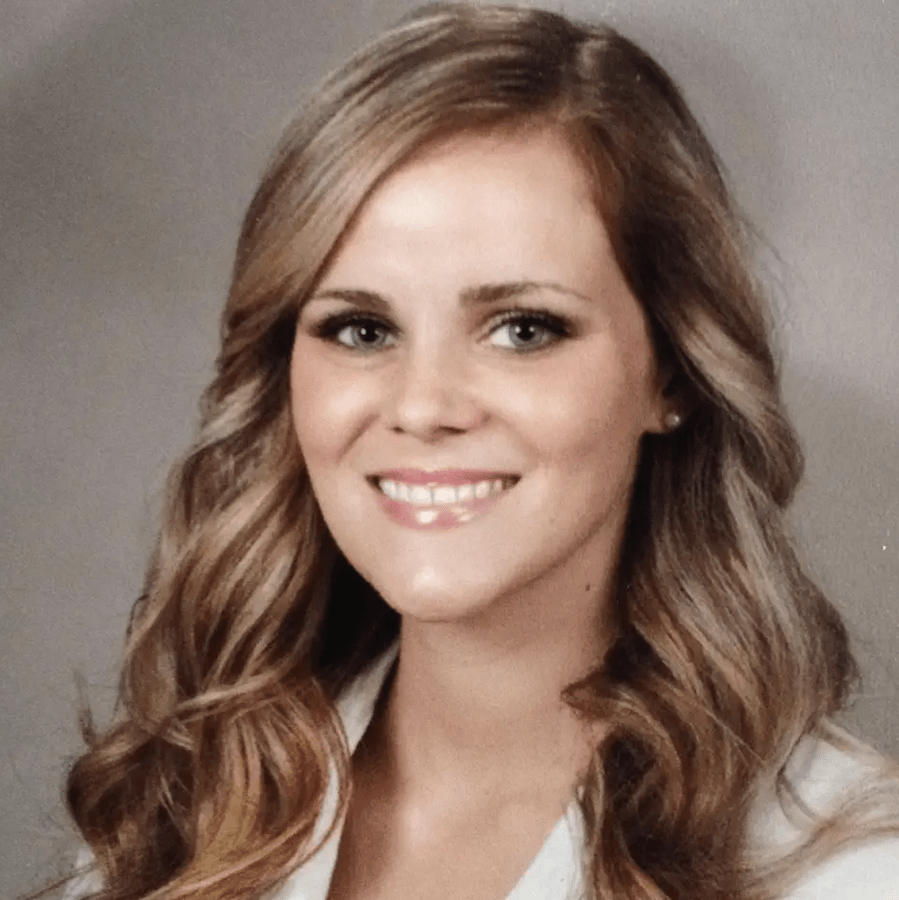
Photo courtesy of Dr. Karen Beste
What is some advice you would give someone who wants to become a veterinarian?
I would recommend they spend as much time as they can with a veterinarian. It is important to understand the commitment that is required and how rewarding it can be working on animals that people not only compete on but truly love as members of their family.
What aspects of equine medicine interest you most, and what types of cases do you find most rewarding?
As a surgeon, I am obviously interested in being in the operating room and helping horses in emergency situations or with routine surgery. I find the most joy in watching a horse I have been involved with have a good outcome in the show ring following surgical intervention.
What is something interesting people may not know about you?
The most exciting animal I have done surgery on was a baby bongo!
There’s nothing more exciting than buying a young horse with a lot of potential. When Margo Crowther of Fort Myers, FL, purchased three-year-old “Sissy” she was looking forward to the young mare’s future as a barrel racer.
In 2016, when Sissy was a four-year-old, Crowther, a professional barrel racer, took the mare to an event in South Carolina. The pair successfully made it to the top 30 in a barrel race competition to qualify for the final taking place the next day. Unfortunately, while making the turn around the first barrel in the final, Sissy slipped and fell down. Crowther came off, caught Sissy, and took her back to the stabling area to check her over.

Photo courtesy of Margo Crowther
“Once we reached the stalls, Sissy began to limp with her hind end,” explained Crowther. “After traveling home, I knew something wasn’t right. We immediately brought her to Dr. Weston Davis at Palm Beach Equine Clinic. Dr. Davis is the best, and he’s a good friend of mine. He was also the only vet that had worked on Sissy at that point.”
Dr. Davis examined Sissy when she arrived at Palm Beach Equine Clinic in Wellington, FL. She was lame at the walk but had no swelling or signs of where the injury was located.
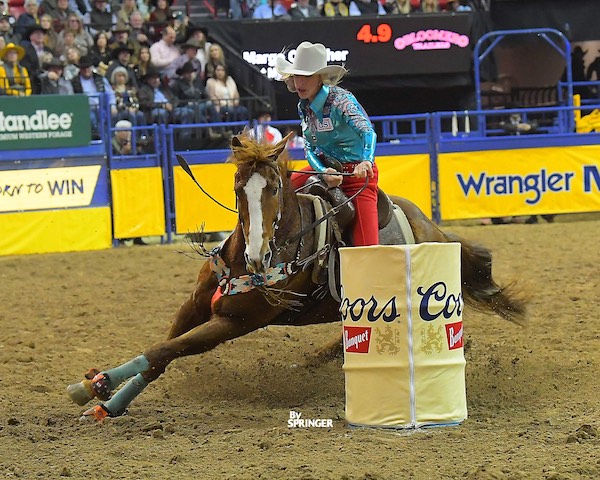
Photo by Springer
“We ended up doing a bone scan to diagnose Sissy,” commented Dr. Davis. “She had a really hot bone scan at the hock. We decided to do several different special x-ray views and found she had a central tarsal bone fracture. This is a very uncommon source of lameness in equine athletes. It was an atypical slab fracture, which meant it spanned from one joint to the next.”
Dr. Davis and his team of veterinarians found the fracture on x-rays, but a standing magnetic resonance imaging (MRI) was performed to help accurately define the fracture configuration.
“We did our surgical planning on the MRI,” said Dr. Davis. “Then we put a screw across the fracture line. A lag screw stabilization promotes compression and primary healing of the bone and is considered the treatment of choice for this type of injury.”
Sissy stayed at Palm Beach Equine Clinic for a few days then returned home to Crowther’s farm where she remained on stall rest for four months. Her next step was a few weeks of daily hand walking, followed by a gradual return to working under saddle. Crowther made sure to take it slow with Sissy, especially in the beginning. Dr. Davis checked the mare on a monthly basis throughout the recovery period. At Sissy’s three-month check-in, Dr. Davis removed the screw.
After a successful recovery, Crowther and Sissy made their return to the show ring exactly seven months after the injury happened. The duo competed in the Fort Smith Derby in Fort Smith, AR, where the pair won $26,000.
“It was a huge accomplishment and even more so since it was her first run back from her injury,” explained Crowther. “We were all shocked, to say the least.”
Sissy is now 11 years old and continues to be Crowther’s main competition horse. In 2022, Crowther and Sissy competed at the National Finals Rodeo, known as the “super bowl of rodeo,” where the pair won $86,000 in prize money. Sissy’s lifetime earnings have topped $450,000.
“Sissy is a family member to my husband and me as well as our kids,” Crowther said of the mare. “She means the world to all of us. My kids joke that if I could build her a stall in the house I would. She is the kindest horse, and she loves her job. She is one in a million.”
Thanks to the team of top veterinarians at Palm Beach Equine Clinic, Sissy was able to have a successful career as a barrel racer. Crowther and Sissy will continue to compete and look forward to more top-place finishes.
Thanks to the team of top veterinarians at Palm Beach Equine Clinic, Sissy was able to have a successful career as a barrel racer. Crowther and Sissy will continue to compete and look forward to more top-place finishes.
Morgan Barbançon (FRA) piloted her own Habana Libre A to the top of the podium in the Grand Prix Special CDI4* presented by Palm Beach Equine Clinic at the Adequan® Global Dressage Festival (AGDF) in Wellington, FL, on Saturday, January 28, 2023.
Barbançon and the 11-year-old Dutch Warmblood gelding received an unbeatable score of 74.404%. The victory was special to Barbançon who has had Habana Libre A since he was four years old.

Photo by Susan J. Stickle Photography
“When I came out and saw the score, I started crying because he has come a long way,” commented Barbançon. “Today I had such a floaty and fluid ride, and I didn’t push. My goal was to give him confidence in the ring and have a fault-free test. That was my goal, and that’s what I had. There were a few hiccups here and there, and there are things that can get better, but it felt like such a nice ride.”
Barbançon is looking forward to continuing her success during the rest of the AGDF season with Habana Libre A.
“I’m looking at the five-star with him,” explained Barbançon. “He’s going to tell me when he’s ready, and I’ll just take it week by week. I’m here until the end of March so there is no rush and no pressure. I’m here to compete as much as I can. I want to give him the confidence in the ring, where he really wants to go and really wants to do it.”
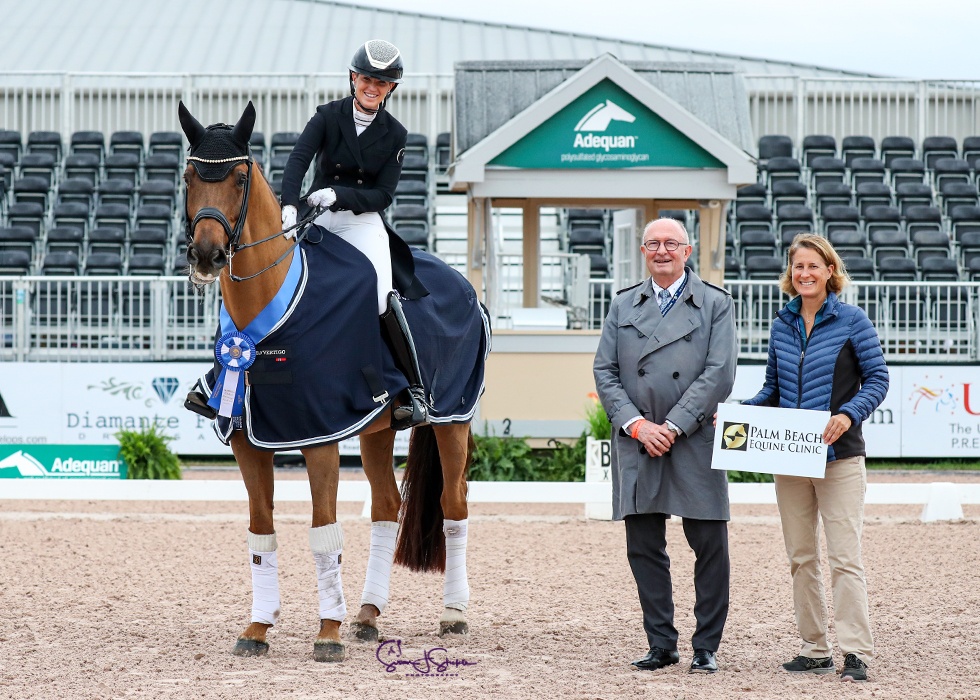
Photo by Susan J. Stickle Photography
Anna-Christina Abbelen (GER) and Sam Donnerhall, owned by Abbelen and Silke Abbelen-Mooren, finished in second place with a score of 71.234%. Pablo Gómez Molina (ESP) and Ulises de Ymas, owned by Javier Bacariza, Cristina Danguillecourt, and Yeguada de Ymas S.L., rounded out the podium after receiving a score of 69.915%.
The FEI Young Horse 7 Year Old Preliminary and FEI Young Horse 7 Year Old Final presented by Palm Beach Equine Clinic took place on Saturday, January 28, and Sunday, January 29. Juan Francisco Fernandez Muñoz (ESP) took top honors in both classes aboard Fraggle Rock, owned by Precision Sport Horses. Muñoz and the seven-year-old gelding received a score of 72.482% on Saturday and a 72.643% on Sunday.
Palm Beach Equine Clinic is the Official Veterinarian of the Adequan® Global Dressage Festival in Wellington, FL. The third week featured the Grand Prix Special CDI4*, the FEI Young Horse 7 Year Old Preliminary, and the FEI Young Horse 7 Year Old Final presented by Palm Beach Equine Clinic. View results, live stream replays, and more at gdf.coth.com.
Palm Beach Equine Clinic is the Official Veterinarian of the Adequan® Global Dressage Festival in Wellington, FL. The third week featured the Grand Prix Special CDI4*, the FEI Young Horse 7 Year Old Preliminary, and the FEI Young Horse 7 Year Old Final presented by Palm Beach Equine Clinic. View results, live stream replays, and more at gdf.coth.com.
The $50,000 Palm Beach Equine Clinic National Grand Prix took place under the lights in the International Arena on Saturday, January 21, 2023, at Wellington International in Wellington, FL, during the third week of the Winter Equestrian Festival (WEF). Kent Farrington (USA) piloted Greya, owned by Kent Farrington LLC, to top honors in the competitive class.
Farrington and Greya went 17th in the starting order of 45 riders and were the first pair to produce a fault-free round over the technical course designed by Catsy Cruz (MEX). Six more horse-and-rider combinations produced clear rounds to join Farrington in the jump-off including Ben Maher (GBR), Jos Verlooy (BEL), Sam Walker (CAN), Bertram Allen (IRL), Michael Murphy (USA), and Mimi Gochman (USA).
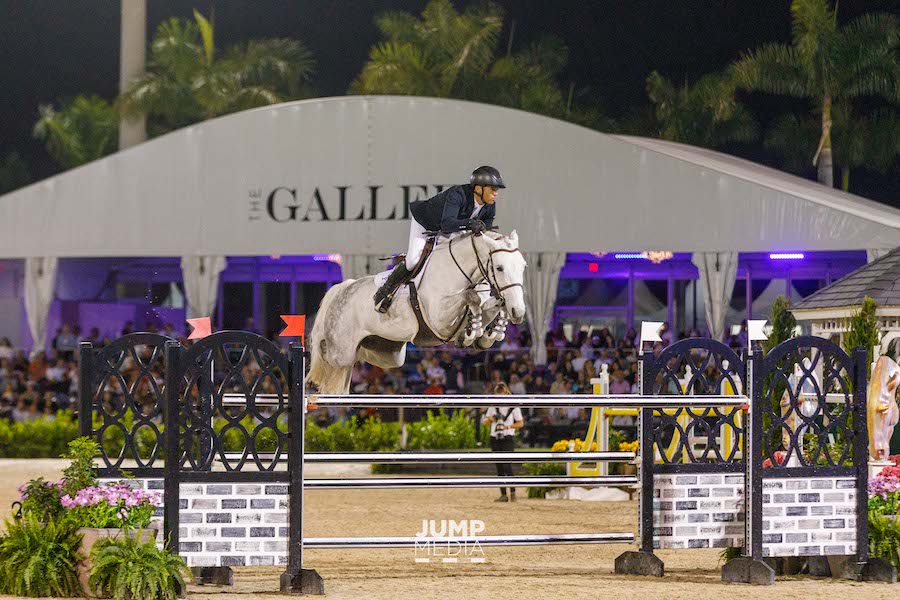
Photo by Jump Media
“It was Greya’s first time jumping under the lights,” said Farrington of the nine-year-old Oldenburg mare (Colestus x Contender). “My plan was to just work out of her normal gallop, which is already pretty quick. Luckily, it worked out tonight.”
Farrington and Greya were the first pair to return for the jump-off and set the pace with a quick time of 37.756 seconds. Although the remaining competitors tried to beat the duo’s time, Farrington and Greya proved to be uncatchable.
“I thought she was incredible,” said Farrington of his mount. “I think it is a very special horse. I thought she jumped great tonight. I think she has a promising future so I’m looking forward to that.

Photo by Jump Media
“She is a very opinionated mare,” continued Farrington. “She has her own ideas, and those types are sort of my favorite horses. I think in the end when you can train the horse to work with you and use all of their energy to go in the right direction they can be great.”
Maher and Enjeu de Grisien, a nine-year-old Selle Français gelding owned by Charlotte Rossetter and Pamela Wright, claimed second-place honors with a time of 38.835 seconds. Verlooy and Nixon Van’t Meulenhof, a 10-year-old Belgian Warmblood stallion owned by Eurohorse BVBA, rounded out the podium after stopping the timers at 39.767 seconds.
Palm Beach Equine Clinic is the Official Veterinarian of the Winter Equestrian Festival in Wellington, FL. Week 2 of the 13-week series featured competition sponsored by Palm Beach Equine Clinic. View results, live stream replays, and more at WellingtonInternational.com.
Palm Beach Equine Clinic is the Official Veterinarian of the Winter Equestrian Festival in Wellington, FL. Week 2 of the 13-week series featured competition sponsored by Palm Beach Equine Clinic. View results, live stream replays, and more at WellingtonInternational.com.